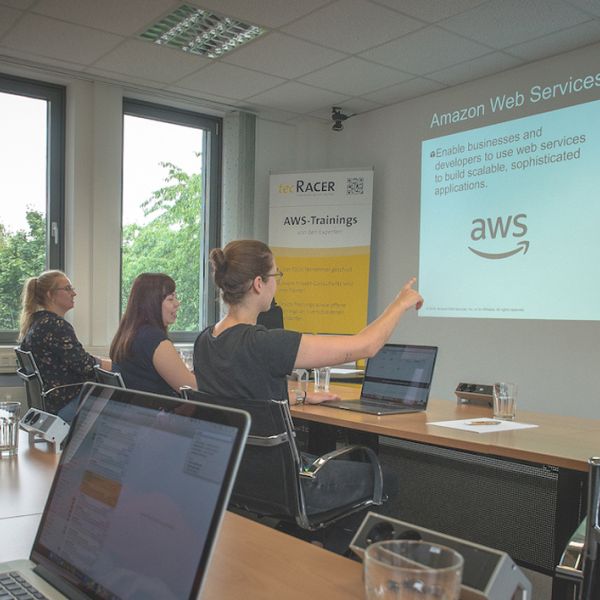Developing Generative AI Applications on AWS
This course is designed to introduce generative artificial intelligence (AI) to software developers interested in using large language models (LLMs) without fine-tuning. The course provides an overview of generative AI, planning a generative AI project, getting started with Amazon Bedrock, the foundations of prompt engineering, and the architecture patterns to build generative AI applications using Amazon Bedrock and LangChain.




Developing Generative AI Applications on AWS
Please find our upcoming course dates at the end of this page!
Course description
This course is designed to introduce generative artificial intelligence (AI) to software developers interested in using large language models (LLMs) without fine-tuning. The course provides an overview of generative AI, planning a generative AI project, getting started with Amazon Bedrock, the foundations of prompt engineering, and the architecture patterns to build generative AI applications using Amazon Bedrock and LangChain.
COURSE OBJECTIVES
In this course, you will learn to:
- Describe generative AI and how it aligns to machine learning
- Define the importance of generative AI and explain its potential risks and benefits
- Identify business value from generative AI use cases
- Discuss the technical foundations and key terminology for generative AI
- Explain the steps for planning a generative AI project
- Identify some of the risks and mitigations when using generative AI
- Understand how Amazon Bedrock works
- Familiarize yourself with basic concepts of Amazon Bedrock
- Recognize the benefits of Amazon Bedrock
- List typical use cases for Amazon Bedrock
- Describe the typical architecture associated with an Amazon Bedrock solution
- Understand the cost structure of Amazon Bedrock
- Implement a demonstration of Amazon Bedrock in the AWS Management Console
- Define prompt engineering and apply general best practices when interacting with foundation models (FMs)
- Identify the basic types of prompt techniques, including zero-shot and few-shot learning
- Apply advanced prompt techniques when necessary for your use case
- Identify which prompt techniques are best suited for specific models
- Identify potential prompt misuses
- Analyze potential bias in FM responses and design prompts that mitigate that bias
- Identify the components of a generative AI application and how to customize an FM
- Describe Amazon Bedrock foundation models, inference parameters, and key Amazon Bedrock APIs
- Identify Amazon Web Services (AWS) offerings that help with monitoring, securing, and governing your Amazon Bedrock applications
- Describe how to integrate LangChain with LLMs, prompt templates, chains, chat models, text
embeddings models, document loaders, retrievers, and Agents for Amazon Bedrock - Describe architecture patterns that you can implement with Amazon Bedrock for building generative AI applications
- Apply the concepts to build and test sample use cases that use the various Amazon Bedrock models, LangChain, and the Retrieval Augmented Generation (RAG) approach
INTENDED AUDIENCE
This course is intended for:
- Software developers interested in using LLMs without fine-tuning
PREREQUISITES
We recommend that attendees of this course have:
- Completed AWS Technical Essentials
- Intermediate-level proficiency in Python
ACTIVITIES
This course includes:
- Presentations
- Demonstrations
- Group exercises
COURSE DURATION / PRICE
- 2 days
- € 1,500.00 (excl. tax) per person (DE)
Course outline
- Module 1: Introduction to Generative AI – Art of the Possible
- Overview of ML
- Basics of generative AI
- Generative AI use cases
- Generative AI in practice
- Risks and benefits
- Module 2: Planning a Generative AI Project
- Generative AI fundamentals
- Generative AI in practice
- Generative AI context
- Steps in planning a generative AI project
- Risks and mitigation
- Module 3: Getting Started with Amazon Bedrock
- Introduction to Amazon Bedrock
- Architecture and use cases
- How to use Amazon Bedrock
- Demonstration: Setting up Bedrock access and using playgrounds
- Module 4: Foundations of Prompt Engineering
- Basics of foundation models
- Fundamentals of prompt engineering
- Basic prompt techniques
- Advanced prompt techniques
- Model-specific prompt techniques
- Demonstration: Fine-tuning a basic text prompt
- Addressing prompt misuses
- Mitigating bias
- Demonstration: Image bias mitigation
- Module 5: Amazon Bedrock Application Components
- Overview of generative AI application components
- Foundation models and the FM interface
- Working with datasets and embeddings
- Demonstration: Word embeddings
- Additional application components
- Retrieval Augmented Generation (RAG)
- Model fine-tuning
- Securing generative AI applications
- Generative AI application architecture
- Module 6: Amazon Bedrock Foundation Models
- Introduction to Amazon Bedrock foundation models
- Using Amazon Bedrock FMs for inference
- Amazon Bedrock methods
- Data protection and auditability
- Demonstration: Invoke Bedrock model for text generation using zero-shot prompt
- Module 7: LangChain
- Optimizing LLM performance
- Using models with LangChain
- Constructing prompts
- Demonstration: Bedrock with LangChain using a prompt that includes context
- Structuring documents with indexes
- Storing and retrieving data with memory
- Using chains to sequence components
- Managing external resources with LangChain agents
- Module 8: Architecture Patterns
- Introduction to architecture patterns
- Text summarization
- Demonstration: Text summarization of small files with Anthropic Claude
- Demonstration: Abstractive text summarization with Amazon Titan using LangChain
- Question answering
- Demonstration: Using Amazon Bedrock for question answering
- Chatbot
- Demonstration: Conversational interface – Chatbot with AI21 LLM
- Code generation
- Demonstration: Using Amazon Bedrock models for code generation
- LangChain and agents for Amazon Bedrock
- Demonstration: Integrating Amazon Bedrock models with LangChain agents
IMPORTANT: Please bring your notebook (Windows, Linux or Mac) to our trainings. If this is not possible, please contact us in advance.
Course materials are in English, on request also in German (if available).
The Course language is German, on request also in English.
Upcoming training dates for: Developing Generative AI Applications on AWS
| Datum | Kurs | Preis pro TN | ||
|---|---|---|---|---|
| 02.09.2024 - 03.09.2024 | Developing Generative AI Applications on AWS Online in - Virtual Classroom | 1.500,00 EUR zzgl. MwSt. | Buchen | |
| 02.09.2024 - 03.09.2024 | Developing Generative AI Applications on AWS Vahrenwalder Straße 156 in 30165 Hannover | 1.500,00 EUR zzgl. MwSt. | Buchen | |
| 04.11.2024 - 05.11.2024 | Developing Generative AI Applications on AWS Online in - Virtual Classroom | 1.500,00 EUR zzgl. MwSt. | Buchen | |
| 04.11.2024 - 05.11.2024 | Developing Generative AI Applications on AWS Vahrenwalder Straße 156 in 30165 Hannover | 1.500,00 EUR zzgl. MwSt. | Buchen |
